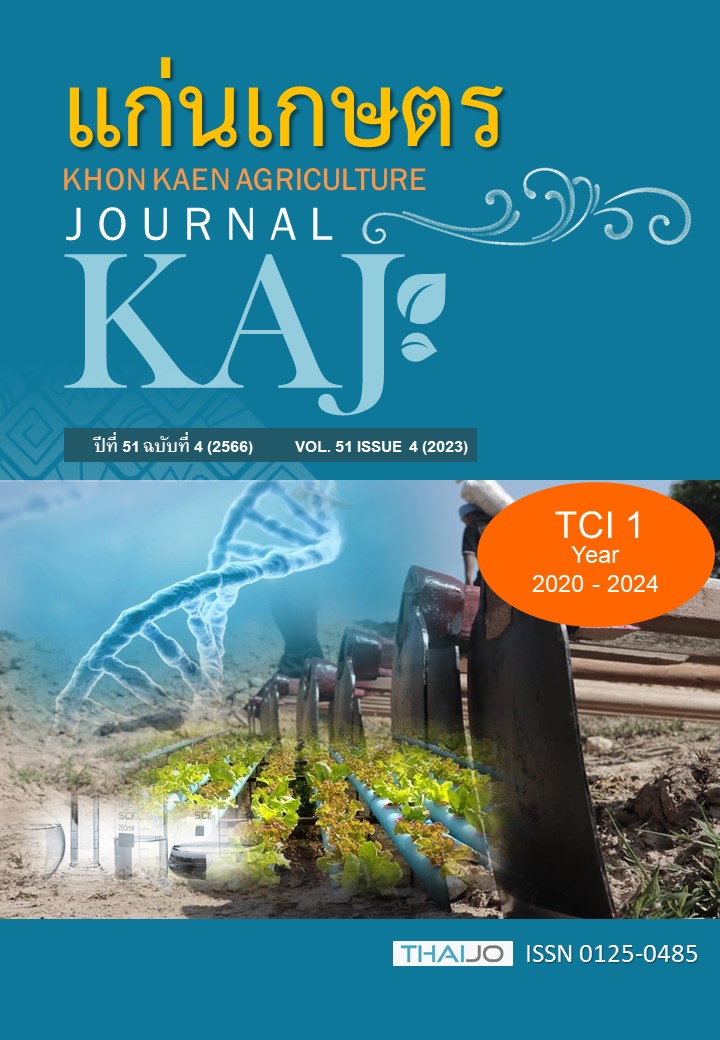สหสัมพันธ์ของปริมาณโพแทสเซียมที่เป็นประโยชน์ในดินที่วิเคราะห์แบบรวดเร็วด้วยอิเล็กโทรดแบบเจาะจงไอออนกับที่สกัดด้วยน้ำยาสกัดโพแทสเซียม
Main Article Content
บทคัดย่อ
การวัดปริมาณโพแทสเซียม (K) แบบรวดเร็วและแม่นยำเป็นประโยชน์ต่อการจัดการธาตุ K เฉพาะพื้นที่ อิเล็กโทรดแบบเจาะจงโพแทสเซียม (K-ISE) มีศักยภาพสำหรับวิเคราะห์โพแทสเซียมในดินภาคสนามแบบรวดเร็ว แต่ยังขาดการปรับค่าความถูกต้องแม่นยำผ่านการหาสหสัมพันธ์กับปริมาณที่สกัดได้โดยใช้น้ำยาสกัดโพแทสเซียมในดิน การศึกษานี้มีวัตถุประสงค์เพื่อวิเคราะห์สหสัมพันธ์ของปริมาณ K โดยวิธี K-ISE กับปริมาณ K ที่วัดด้วยเครื่อง Atomic absorptionspectrophotometer (K-AAS) ในน้ำยาสกัดทั้งหมด 6 ชนิด ได้แก่ NH4OAc, BaCl2, CaCl2, Kelowna, Mehlich III และ distilled water และวิเคราะห์สหสัมพันธ์ของปริมาณ K โดยวิธี K-ISE กับ soluble K, exchangeable K, non-exchangeable K และ Total K โดยใช้ตัวอย่างดินในพื้นที่การเกษตร 70 ตัวอย่าง จำแนกออกเป็นกลุ่มตามเนื้อดินเป็นกลุ่มเนื้อดินเหนียว (Clayey texture) กลุ่มเนื้อดินร่วน (Loamy texture) และกลุ่มเนื้อดินทราย (Sandy texture) ผลการศึกษา พบว่า ปริมาณ K ในดินส่วนใหญ่อยู่ในรูปที่แลกเปลี่ยนไม่ได้มากกว่ารูปที่แลกเปลี่ยนได้และรูปที่ละลายได้ ปริมาณ K ระหว่างวิธี K-ISE และ K-AAS มีความสัมพันธ์เชิงเส้นตรงอย่างมีนัยสำคัญยิ่งทางสถิติ จากผลการวิเคราะห์การยอมรับระหว่างวิธีการด้วย Bland-Altman Plot ยืนยันได้ว่าวิธีการวิเคราะห์ปริมาณ K โดย K-ISE สอดคล้องกับวิธี K-AAS ในระดับที่ยอมรับได้ การสกัดดินด้วยน้ำยาสกัด Kelowna และวิเคราะห์ปริมาณ K ด้วยวิธี K-ISE มีความจำเพาะมากกับโพแทสเซียมที่แลกเปลี่ยนได้ในดิน ซึ่งบ่งชี้ถึงความเป็นประโยชน์ของ K ในดิน ดังนั้น ปริมาณ K ซึ่งวิเคราะห์โดยวิธี K-ISE จึงมีแนวโน้มสามารถใช้เป็นดัชนีบ่งชี้ความเป็นประโยชน์ของโพแทสเซียมสำหรับการให้คำแนะนำปุ๋ยโพแทสเซียมตามค่าวิเคราะห์ดินได้
Article Details

อนุญาตภายใต้เงื่อนไข Creative Commons Attribution-NonCommercial-NoDerivatives 4.0 International License.
เอกสารอ้างอิง
Brouder, S.M., M. Thom, V.I. Adamchuck, and M.T. Morgan. 2003. Potential Uses of Ion-Selective Potassium Electrodes in Soil Fertility Management. Communications in Soil Science and Plant Analysis. 34: 19–20.
Chapman, H.D. 1965. Cation-exchange capacity, P. 891–901. In C.A. Black, ed. Method of Soil Analysis. Part 2. Chemical and Microbiological Properties. Agronomy No. 9. American Society of Agronomy, Inc., Madison, Wisconsin, USA.
Cieśla, J., M. Ryzak, A. Bieganowski, P. Tkaczyk, and R.T. Walczak. 2007. Use of ion-selective electrodes for determination of content of potassium in Egner-Rhiem soil extracts. Research in Agricultural Engineering. 53: 1.
Dimeski, G., T. Badrick, and A. S. John. 2010. Ion Selective Electrodes (ISEs) and interferences A review. Clinica Chimica Acta. 411(5–6): 309–317.
Frant, M.S., and J.W. Ross. 1970. Potassium ion specific electrode with high selectivity for potassium over sodium. Science. 167(3920): 987–988.
Gee, G.W., and J.W. Bauder. 1986. Particle-size analysis. P. 383-409. In A. Klute. (ed). Methods of Soil Analysis Part 1: Physical and Mineralogical Methods. American Society of Agronomy. Inc, Wisconsin USA.
Giavarina, D. 2015. Understanding Bland Altman analysis. Biochem Med (Zagreb). 25(2): 141–151.
Johnson, C.M., and A. Ulrich. 1959. Analytical methods for use in plant analysis, pp. 26–78. Bulletin of the California Agricultural Experiment Station No. 766. Berkeley, California, USA.
Kim, H.J., J.W. Hummel, K.A. Sudduth, and P.P. Motavalli. 2007. Simultaneous analysis of soil macronutrients using ion-selective electrodes. Soil Science Society of America Journal. 71: 1867-1877.
Linan, Z., and Z. Miao. 2013. Screening of pretreatment parameters for novel solid-state ISE-based soil extractable potassium detection, pp. 947-953. In IEEE 11th International Conference on Electronic Measurement & Instruments, Harbin, China.
Mehlich, A. 1984. Mehlich 3 soil test extractant: A modification of Mehlich 2 extractant. Communications in Soil Science and Plant Analysis. 15: 1409–1416.
Salomon, E. 1998: Extraction of soil potassium with 0.01M calcium chloride compared to official Swedish methods. Communications in Soil Science and Plant Analysis. 29: 2841–2854.
Schollenberger, C., and R. Simon. 1945. Determination of exchange capacity and exchangeable bases in soil—ammonium acetate method. Soil Science. 59(1): 13-24.
Simard, R.R., and J. Zizka. 1994. Evaluating plant available potassium with strontium citrate. Communications in Soil Science and Plant Analysis. 25: 1779–1789.
Sparks, D.L., A.L. Page, P.A. Helmke, and R.H. Loeppert. 1996. Methods of Soil Analysis Part 3-Chemical Methods. Soil Science Society and America Book Series 5.3., Madison, WI.
Sumner, M.E., and W.P. Miller. 1996. Cation Exchange Capacity and Exchange Coefficients. In: Sparks, D.L., A.L. Page, P.A. Helmke and R.H. Loeppert. 1996. Methods of Soil Analysis Part 3-Chemical Methods. Soil Science Society and America Book Series 5.3., Madison, WI.
Thomas, G. W. 1982. Exchangeable Cations. P 159-165. In Page A. L, R. H. Miller and D. R. Keeney, eds. Methods of Soil Analysis, Part 2, Chemical and Microbiological Properties. 2nd. Agronomy, No. 9, Part 2, American Society of Agronomy, Soil Science Society of America, Madison, Wl.
Walkley, A., and I.A. Black. 1934. An examination of the Degtjareff method for determining soil organic matter, and a proposed modification of the chromic acid titration method. Soil Sience. 37(1): 29-38.
Wang, J.J., and A.D. Scott. 2001. Determination of exchangeable potassium in soil using ion-selective electrodes in soil suspensions. European Journal of Soil Science. 52: 143-150.
Warncke, D., and J.R. Brown. 1998. Potassium and Other Basic Cations. P. 31-33 .In Brown, J.R., ed. Recommended Chemical Soil Test Procedures for the North Central Region, NCR Publication No. 221, Missouri Agricultural Experiment Station, Columbia.
Zdrachek, E., and E. Bakker. 2020. Potentiometric Sensor Array with Multi-Nernstian Slope. Analytical Chemistry. 92: (4): 2926–2930.


